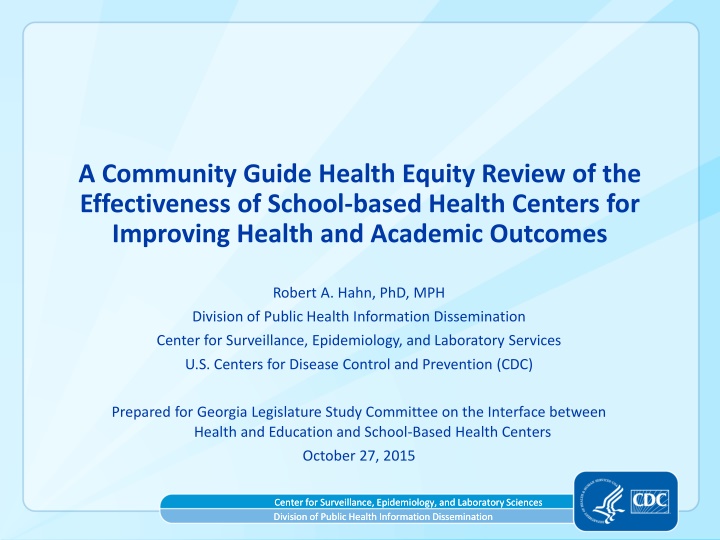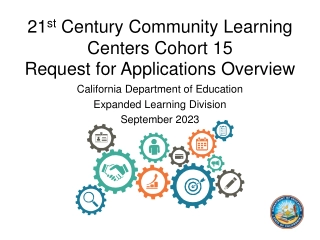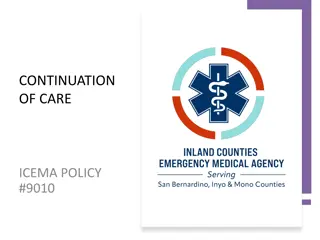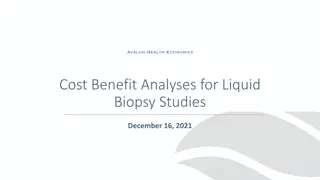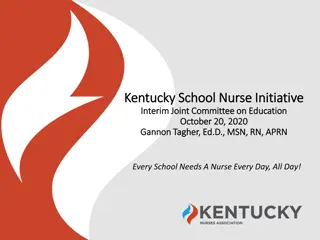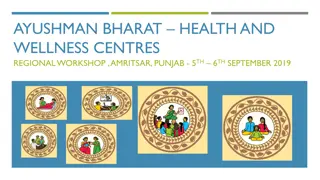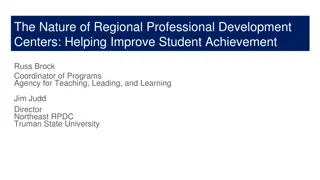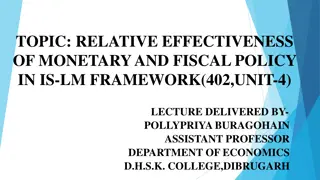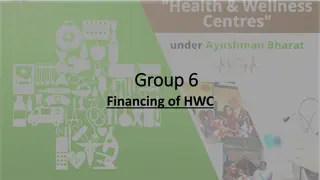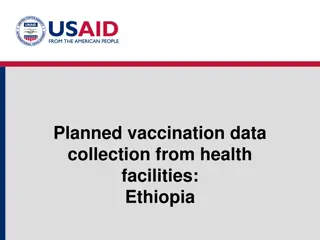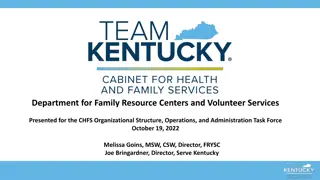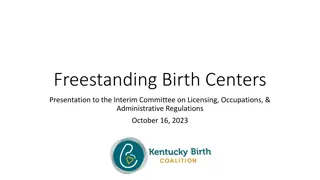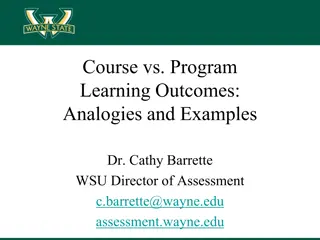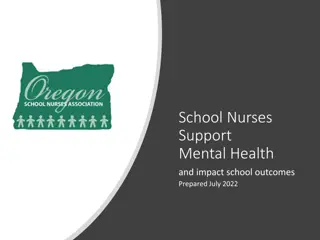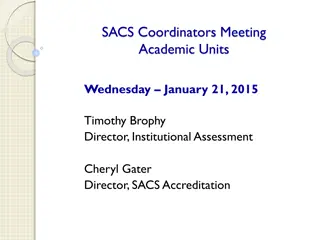Effectiveness of School-based Health Centers for Health and Academic Outcomes
A review by Robert A. Hahn, PhD, MPH, for the Georgia Legislature Study Committee highlights the positive impact of school-based health centers on health and academic outcomes. Benefits include improved health outcomes such as increased vaccinations, reduced asthma incidents, and better health risk behaviors, along with enhanced educational outcomes including school performance and high school completion rates. The Community Preventive Services Task Force recommends implementing and maintaining such centers in low-income communities to support overall well-being and success.
Uploaded on Oct 01, 2024 | 6 Views
Download Presentation

Please find below an Image/Link to download the presentation.
The content on the website is provided AS IS for your information and personal use only. It may not be sold, licensed, or shared on other websites without obtaining consent from the author.If you encounter any issues during the download, it is possible that the publisher has removed the file from their server.
You are allowed to download the files provided on this website for personal or commercial use, subject to the condition that they are used lawfully. All files are the property of their respective owners.
The content on the website is provided AS IS for your information and personal use only. It may not be sold, licensed, or shared on other websites without obtaining consent from the author.
E N D
Presentation Transcript
A Community Guide Health Equity Review of the Effectiveness of School-based Health Centers for Improving Health and Academic Outcomes Robert A. Hahn, PhD, MPH Division of Public Health Information Dissemination Center for Surveillance, Epidemiology, and Laboratory Services U.S. Centers for Disease Control and Prevention (CDC) Prepared for Georgia Legislature Study Committee on the Interface between Health and Education and School-Based Health Centers October 27, 2015 Center for Surveillance, Epidemiology, and Laboratory Sciences Division of Public Health Information Dissemination Division of Public Health Information Dissemination Center for Surveillance, Epidemiology, and Laboratory Sciences
Disclaimer The findings and conclusions in this presentation do not necessarily represent the official position of the Centers for Disease Control and Prevention. The Community Preventive Services Task Force s evidence-based recommendations are not mandates for compliance or spending. Instead, they provide information and options for decision makers and stakeholders to consider when determining which programs, services, and policies best meet the needs, preferences, available resources, and constraints of their constituents. The Centers for Disease Control and Prevention provides administrative, research, and technical support for the Community Preventive Services Task Force. [PHS Act 399U[c] 2
Presentation Theme The Community Preventive Services Task Force recommends the implementation and maintenance of school-based health centers in low-income communities. School-based health centers are associated with Improved health outcomes: Increased vaccinations and other preventive services Fewer asthma incidents Fewer emergency department and hospital admissions Increased contraceptive use among females Increased prenatal care and birth weight Better health risk behaviors Improved educational outcomes: School performance Grade promotion High school completion 3
The Community Guide Systematic reviews Evaluate and analyze all available evidence on the effectiveness of community-based programs, services, and policies in public health Assess the economic benefit of effective programs, services, policies Highlight evidence gaps Evidence-based findings and recommendations About the effectiveness of these programs, services, and policies Help inform decision-making Developed by the Community Preventive Services Task Force (Task Force) www.thecommunityguide.org 5
Community Preventive Services Task Force A non-federal, independent, non-partisan panel Renowned experts in public health research, practice, and policy Members are appointed by CDC Director Serve without compensation for this work CDC provides administrative, research, and technical support for the Community Preventive Services Task Force 6
School-Based Health Centers: Definition School-Based Health Centers (SBHCs) are systems of health services provided to students at centers within K-12 schools (i.e., school-based) or at off-site health facilities linked to the schools (i.e., school-linked). Most SBHCs are targeted to low- income students. Services must include primary health care. Services may also include mental health care, social services, dentistry, and health education. Minimally, primary care services are provided by a single clinician (e.g., nurse practitioner, physician assistant, or physician). Comprehensive services may be provided by multi-disciplinary teams. Services need not be available during all school hours or days. Student participation requires parental consent, and services may be limited for specific forms of care, such as reproductive and mental health. Services may also be provided to school staff, student family members, and others in the surrounding community. 6
Research Questions How effective are SBHCs in improving health and educational outcomes in student bodies? Does the use of SBHCs improve the health and educational outcomes of users? 7
Review Coordination Team Staff Team Robert A. Hahn John Knopf Ramona Finnie Yinan Peng Task Force Members Robert Johnson (Rutgers New Jersey Medical School) Jonathan Fielding (UCLA Fielding School of Public Health) Task Force Liaison Member Regina Davis Moss (American Public Health Association) CDC Library Specialist: Onnalee Gomez CDC Partners Benedict I. Truman Camara Jones Pete Hunt Mary Vernon-Smiley Joi Hudson Ingrid Hall Gia Rutledge External Partners Irene Dankwa-Mullan (NIH) Carles Muntaner (U Toronto) Jacqueline Buckley (US Dept Education) Mindy Fullilove (Columbia) Steven Barnett (National Institute for Early Education Research) David Williams (Harvard) 8
Analytic Framework: School-Based Health Centers to Promote Health Equity Improved school achievement Health education: Nutrition Sexual behavior Substance abuse Physical activity Mental health Reduced risk behavior Federal, state, local policies Reduced teen births Reduced health care misuse Patient comfort/ satisfaction Increased/earlier treatment: Infectious diseases Chronic diseases Dental health Mental health Reduced morbidity and injury School-Based Health Centers Increased use of recommended preventive services Improved health of low-income and minority students Increased access to services (medical, mental health, dental, social) Reduced transportation time, cost Reduced parental health- care time Decreased fragmentation of care Increased/ earlier diagnosis Health Equity Key Effect Modifier - Available community health care - Parental engagement - School-based/linked - Record Sharing Increased proportion with medical home 9
METHODS 10
In General, a Conclusion on Effectiveness Requires: A Body of Evidence A Demonstration of Effectiveness + More than one study Fewer if high quality Consistency of Effect Sufficient Magnitude of Effect + More if lower quality Most studies demonstrated an effect in the direction of the intervention The effect demonstrated across the body of evidence is meaningful 11
Two Basic Comparison Options 1. Studies of School Student Body: Comparison of settings including both users and non-users, i.e., the student body. 2. Studies of SBHC Users: Comparison of settings including only users, e.g., students in a school with an SBHC who use the SBHC, compared either with students in the SBHC school who do not use the SBHC or with students in a school without an SBHC who use community resources. 12
Body of Evidence (N=48) Quality of Execution (# penalties) Suitability of Study Design (# studies) Greatest Moderate Least 9 12 Britto 01, Gibson 13 Guo 05, Guo 08, Key 02, Ricketts 06, Robinson 03, Wade 05, Walker 10 Allison 07, Berg 79, Frederico 10, Hutchinson 12, Kaplan 98, Kaplan 99, Kirby 89/91, Santelli 96, Setzer 92, Smith 11, Young 01, Zimmer-Gembeck 01 17 Barnett 03, Edwards 77, Ethier 01, Foy 09, Gance-Cleveland 05, Denny 12, Juszczak 03, Kirby 93, Klein 07, Klosterman 00, Lewin 97*, Lurie 01, McCord 93, Silberberg 08, Strolin-Goltzman 14, Taylor 83, Webber 03, Zimmer-Gembeck 97 4 Bourne 71, Dallas ISD 06, Jennings 00, Jones 97 Good (0-1) -- 6 Kerns 11, Kisker 96, Lewin 97*, McNall 10, Warren 00, Weist 93 Fair (2-4) - Limited (>4) - - Included studies: 44 Excluded studies: 4 13 * Citations include separate studies with different features
* * 16
* * 17
* * 20
Overall Review Assessment Body of evidence: 32% greatest suitability of design; 50% fair quality Impact on recommended preventive services Magnitude of effect meaningful? Consistent across the body of evidence? Impact on morbidity Asthma o Magnitude of effect meaningful? o Consistent across the body of evidence? Physical Health o Magnitude of effect meaningful? o Consistent across the body of evidence? Mental Health o Magnitude of effect meaningful? o Consistent across the body of evidence? 44 studies Yes Yes Yes Yes No Yes No No 17
Overall Review Assessment, Contd Impact on misuse of medical care resources Magnitude of effect meaningful? Consistent across the body of evidence? Impact on source of regular health care services Magnitude of effect meaningful? Consistent across the body of evidence? Impact on reproductive health Magnitude of effect meaningful? Consistent across the body of evidence? Impact on other risk behaviors Magnitude of effect meaningful? Consistent across the body of evidence? Impact on educational outcomes Magnitude of effect meaningful? Consistent across the body of evidence? Team assessment Sufficient evidence of effectiveness Yes Yes Yes Yes No No Yes Unclear Yes Yes 18
Economic Evidence For interventions found to be effective, the Community Guide systematically reviews economic evidence. The only two available studies examined benefit: cost ratios from a societal perspective. One found benefits were 1.38 times costs. The other found that benefits were 3.05 times costs. 19
Task Force Finding Statement The Community Preventive Services Task Force recommends the implementation and maintenance of school-based health centers (SBHCs) in low-income communities, based on sufficient evidence of effectiveness in improving educational and health outcomes. Improved educational outcomes include school performance, grade promotion, and high school completion. Improved health outcomes include the delivery of vaccinations and other recommended preventive services, asthma morbidity, emergency department and hospital admissions, contraceptive use among females, prenatal care and birth weight, and other health risk behaviors. 20
Task Force Finding Statement (Continued) Most evidence derives from studies of SBHCs in low-income populations. As SBHCs are commonly implemented in low- income communities and communities with high proportions of racial and ethnic minority populations, many of whom are low- income, this source of student health care and health education may be a prominent means of advancing health equity. http://www.thecommunityguide.org/healthequity/education/schoolbasedhealthcenters.html 21
Discussion Center for Surveillance, Epidemiology, and Laboratory Sciences Division of Public Health Information Dissemination Division of Public Health Information Dissemination Center for Surveillance, Epidemiology, and Laboratory Sciences
